This site uses cookies as defined in our Cookie Policy, by continuing to use this site you agree to their use.
Continue
| Arrive | Depart | ||||||
| 14th14 | AprApr | 202525 | Yokohama, Japan, embark on the Norwegian Spirit | 17:00 | |||
In 1853, a fleet of four American warships under Commodore Matthew Perry sailed into the bay of Tokyo (then Edo) and presented the reluctant Japanese with the demands of the U.S. government for the opening of diplomatic and commercial relations. The following year Perry returned and first set foot on Japanese soil at Yokohama—then a small fishing village on the mudflats of Tokyo bay. Two years later New York businessman Townsend Harris became America's first diplomatic representative to Japan. In 1858 he was finally able to negotiate a commercial treaty between the two countries; part of the deal designated four locations—one of them Yokohama—as treaty ports. In 1859 the shogunate created a special settlement in Yokohama for the growing community of merchants, traders, missionaries, and other assorted adventurers drawn to this exotic new land of opportunity. The foreigners (predominantly Chinese and British, plus a few French, Americans, and Dutch) were confined here to a guarded compound about 5 square km (2 square miles)—placed, in effect, in isolation—but not for long. Within a few short years the shogunal government collapsed, and Japan began to modernize. Western ideas were welcomed, as were Western goods, and the little treaty port became Japan's principal gateway to the outside world. In 1872 Japan's first railway was built, linking Yokohama and Tokyo. In 1889 Yokohama became a city; by then the population had grown to some 120,000. As the city prospered, so did the international community and by the early 1900s Yokohama was the busiest and most modern center of international trade in all of East Asia. Then Yokohama came tumbling down. On September 1, 1923, the Great Kanto Earthquake devastated the city. The ensuing fires destroyed some 60,000 homes and took more than 40,000 lives. During the six years it took to rebuild the city, many foreign businesses took up quarters elsewhere, primarily in Kobe and Osaka, and did not return. Over the next 20 years Yokohama continued to grow as an industrial center—until May 29, 1945, when in a span of four hours, some 500 American B-29 bombers leveled nearly half the city and left more than half a million people homeless. When the war ended, what remained became—in effect—the center of the Allied occupation. General Douglas MacArthur set up headquarters here, briefly, before moving to Tokyo; the entire port facility and about a quarter of the city remained in the hands of the U.S. military throughout the 1950s. By the 1970s Yokohama was once more rising from the debris; in 1978 it surpassed Osaka as the nation's second-largest city, and the population is now inching up to the 3.5 million mark. Boosted by Japan's postwar economic miracle, Yokohama has extended its urban sprawl north to Tokyo and south to Kamakura—in the process creating a whole new subcenter around the Shinkansen Station at Shin-Yokohama. The development of air travel and the competition from other ports have changed the city's role in Japan's economy. The great liners that once docked at Yokohama's piers are now but a memory, kept alive by a museum ship and the occasional visit of a luxury vessel on a Pacific cruise. Modern Large as Yokohama is, the central area is very negotiable. As with any other port city, much of what it has to offer centers on the waterfront—in this case, on the west side of Tokyo Bay. The downtown area is called Kannai (literally, "within the checkpoint"); this is where the international community was originally confined by the shogunate. Though the center of interest has expanded to include the waterfront and Ishikawa-cho, to the south, Kannai remains the heart of town. Think of that heart as two adjacent areas. One is the old district of Kannai, bounded by Basha-michi on the northwest and Nippon-odori on the southeast, the Keihin Tohoku Line tracks on the southwest, and the waterfront on the northeast. This area contains the business offices of modern Yokohama. The other area extends southeast from Nippon-odori to the Moto-machi shopping street and the International Cemetery, bordered by Yamashita Koen and the waterfront to the northeast; in the center is Chinatown, with Ishikawa-cho Station to the southwest. This is the most interesting part of town for tourists. Whether you're coming from Tokyo, Nagoya, or Kamakura, make Ishikawa-cho Station your starting point. Take the South Exit from the station and head in the direction of the waterfront. | |||||||
| 15th15 | AprApr | 202525 | Sendai, Japan | 11:00 | 18:00 | ||
| 16th16 | AprApr | 202525 | Hakodate, Japan | 10:00 | 17:00 | ||
Facing out on two bays, Hakodate is a 19th-century port town, with clapboard buildings on sloping streets, a dockside tourist zone, streetcars, and fresh fish on every menu. In the downtown historic quarter, a mountain rises 1,100 feet above the city on the southern point of the narrow peninsula. Russians, Americans, Chinese, and Europeans have all left their mark; this was one of the first three Japanese ports the Meiji government opened up to international trade in 1859. The main sights around the foot of Mt. Hakodate can be done in a day, but the city is best appreciated with an overnight stay for the illumination in the historic area, the night views from either the mountain or the fort tower, and the fish market at dawn. City transport is easy to navigate and English information is readily available. Evening departure trains from Tokyo arrive here at dawn—perfect for fish-market breakfasts. | |||||||
| 17th17 | AprApr | 202525 | Sapporo, Japan | 08:00 | 16:00 | ||
| 18th18 | AprApr | 202525 | Akita, Japan | 09:00 | 16:00 | ||
| 19th19 | AprApr | 202525 | Kanazawa, Japan | 08:00 | 16:00 | ||
The capital of the Ishikawa Prefecture, Kanazawa once rivalled Kyoto and Edo (Tokyo) as a town rich in cultural achievements. Kanazawa escaped destruction during World War II and accordingly has been able to preserve many of the old districts in good shape. The city is famous because of Kenrokuen. Located next to Kanazawa Castle, Kenrokuen is classified as “One of the Three Gardens of Japan”. The garden has an artificial pond, and hills and houses are dotted within the 11.4 hectares. It has Japan’s oldest fountain using natural water pressure and a tea-house dating back to 1774. Close by is the Higashi Chaya Gai Geisha District, designated a National Cultural Asset and the biggest of the Geisha districts of Kanazawa. Some of the houses not only retain the original structure, but still are used as Geisha houses. Some of the streets have traditional shops creating a nostalgic atmosphere. Kanazawa is also known for its lacquer ware, Kutani-style pottery, gold-leaf workmanship and delicately painted silk kimonos. | |||||||
| 20th20 | AprApr | 202525 | Busan, South Korea | 15:00 | 22:00 | ||
White-sand city beaches and hot-spring resorts may not be everyone's first image of Korea, but these are what Koreans flock to Busan for all year. And there are plenty of opportunities for rest, relaxation, retail therapy, and even a touch of glamour every October with the Busan International Film Festival. Busan's beaches are the big summertime draw but there is plenty to be seen year round. Quintessential experiences include taking some rest and relaxation at a local spa and exploring the Beomeosa temple complex. | |||||||
| 21st21 | AprApr | 202525 | Nagasaki, Japan | 09:00 | 19:00 | ||
Nagasaki city has developed into one of the most important port cities in Japan. During Japan’s period of isolation in the 17th century, Nagasaki played a prominent role in foreign trade relation and only a very few ports were open to restricted numbers of foreign traders. Even though Holland was a major country who conducted trading during this period, Dutch people were only allowed to stay in Dejima Island and were not allowed to have contact with the Japanese people. Today, you will still find the strong influence of Dutch and Chinese culture in the city which is very different from all other cities in Japan. In the more recent history, Nagasaki became the second city after Hiroshima to be destroyed by an atomic bomb towards the end of World War II. From the visit to Atomic bomb museum and peace memorial park, people could understand how chaotic the situation was and the agony that the people in the days have experienced from the damage inflicted by the atomic bomb. It continues to appeal to the world with their wish for world peace. | |||||||
| 22nd22 | AprApr | 202525 | Kagoshima, Japan | 06:00 | 14:00 | ||
Kagoshima city is the capital of Kagoshima prefecture and also Kyushu’s southernmost major city. This city is often compared to its Italian sister city Naples, due to its’s similarities such as mild climate and active volcano, Sakurajima. Sakurajima is one of the most renowned active volcanos not only in Japan but also in the whole entire world. This smoking Sakurajima is centred in Kinko Bay and is one of the main symbols of this prefecture. We cannot talk about Sakurajima without the history of continuous eruption. Sakurajima used to be an isolated island; however, the land has banded together with Osumi peninsula from the eruption in 1914. You may have a chance to see the smoke coming from the top of Sakurajima depending on the weather condition. Not only does the scenery of Sakurajima represent the beauty of Kagoshima City but Senganen garden is also symbolic to elegance in the Kagoshima region. This Japanese garden was constructed by a feudal lord, Mitsuhisa Shimazu, as a guest house of the Kagoshima castle which attracts many visitors for its splendid view. | |||||||
| 23rd23 | AprApr | 202525 | Tokushima, Japan | 11:00 | |||
| 24th24 | AprApr | 202525 | Tokushima, Japan | 18:00 | |||
| 25th25 | AprApr | 202525 | Shimizu, Japan | 10:00 | 19:00 | ||
The salt and pepper cone of Japan's most famous natural landmark won’t fail to take your breath away, as it soars into the sky in a vision of spectacular symmetry. Make sure your camera is fully prepared before you dock in Shimizu’s port, where unparalleled views of the extraordinary Mount Fuji’s dramatic peak await. Take your time to soak up one of Japan's most iconic views, before dipping your toes into the rest of what this destination of tranquil temples has to offer. While there’s a bustling fish market, and a charming amusement park waiting close to the port, most new arrivals immediately set off in pursuit of the best views of Mount Fuji, or to see the stunning panorama on offer from the heights of the Kunozan Toshogu Shrine. Take the cable car up to the top, to experience the tranquillity around the forested shrine, and to enjoy its stunning architecture of deep scarlets and gleaming golds. You can also enjoy heart-stopping views out over the Bay of Suruga, and the tea plantations below. | |||||||
| 26th26 | AprApr | 202525 | Yokohama, Japan, disembark the Norwegian Spirit | 07:30 | |||
In 1853, a fleet of four American warships under Commodore Matthew Perry sailed into the bay of Tokyo (then Edo) and presented the reluctant Japanese with the demands of the U.S. government for the opening of diplomatic and commercial relations. The following year Perry returned and first set foot on Japanese soil at Yokohama—then a small fishing village on the mudflats of Tokyo bay. Two years later New York businessman Townsend Harris became America's first diplomatic representative to Japan. In 1858 he was finally able to negotiate a commercial treaty between the two countries; part of the deal designated four locations—one of them Yokohama—as treaty ports. In 1859 the shogunate created a special settlement in Yokohama for the growing community of merchants, traders, missionaries, and other assorted adventurers drawn to this exotic new land of opportunity. The foreigners (predominantly Chinese and British, plus a few French, Americans, and Dutch) were confined here to a guarded compound about 5 square km (2 square miles)—placed, in effect, in isolation—but not for long. Within a few short years the shogunal government collapsed, and Japan began to modernize. Western ideas were welcomed, as were Western goods, and the little treaty port became Japan's principal gateway to the outside world. In 1872 Japan's first railway was built, linking Yokohama and Tokyo. In 1889 Yokohama became a city; by then the population had grown to some 120,000. As the city prospered, so did the international community and by the early 1900s Yokohama was the busiest and most modern center of international trade in all of East Asia. Then Yokohama came tumbling down. On September 1, 1923, the Great Kanto Earthquake devastated the city. The ensuing fires destroyed some 60,000 homes and took more than 40,000 lives. During the six years it took to rebuild the city, many foreign businesses took up quarters elsewhere, primarily in Kobe and Osaka, and did not return. Over the next 20 years Yokohama continued to grow as an industrial center—until May 29, 1945, when in a span of four hours, some 500 American B-29 bombers leveled nearly half the city and left more than half a million people homeless. When the war ended, what remained became—in effect—the center of the Allied occupation. General Douglas MacArthur set up headquarters here, briefly, before moving to Tokyo; the entire port facility and about a quarter of the city remained in the hands of the U.S. military throughout the 1950s. By the 1970s Yokohama was once more rising from the debris; in 1978 it surpassed Osaka as the nation's second-largest city, and the population is now inching up to the 3.5 million mark. Boosted by Japan's postwar economic miracle, Yokohama has extended its urban sprawl north to Tokyo and south to Kamakura—in the process creating a whole new subcenter around the Shinkansen Station at Shin-Yokohama. The development of air travel and the competition from other ports have changed the city's role in Japan's economy. The great liners that once docked at Yokohama's piers are now but a memory, kept alive by a museum ship and the occasional visit of a luxury vessel on a Pacific cruise. Modern Large as Yokohama is, the central area is very negotiable. As with any other port city, much of what it has to offer centers on the waterfront—in this case, on the west side of Tokyo Bay. The downtown area is called Kannai (literally, "within the checkpoint"); this is where the international community was originally confined by the shogunate. Though the center of interest has expanded to include the waterfront and Ishikawa-cho, to the south, Kannai remains the heart of town. Think of that heart as two adjacent areas. One is the old district of Kannai, bounded by Basha-michi on the northwest and Nippon-odori on the southeast, the Keihin Tohoku Line tracks on the southwest, and the waterfront on the northeast. This area contains the business offices of modern Yokohama. The other area extends southeast from Nippon-odori to the Moto-machi shopping street and the International Cemetery, bordered by Yamashita Koen and the waterfront to the northeast; in the center is Chinatown, with Ishikawa-cho Station to the southwest. This is the most interesting part of town for tourists. Whether you're coming from Tokyo, Nagoya, or Kamakura, make Ishikawa-cho Station your starting point. Take the South Exit from the station and head in the direction of the waterfront. | |||||||











The images shown are for illustration purposes only and may not be an exact representation of what you find on the ship.
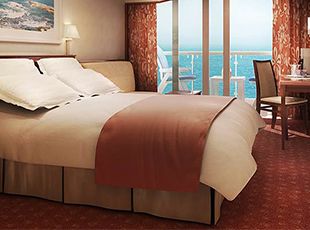
| Grade Code | From | To | |
| BF | Balcony | £2,430 | £2,430 |
| BC | Balcony | £2,865 | £2,865 |
| BB | Mid-Ship Balcony | £2,895 | £2,895 |
| BA | Mid-Ship Balcony | £2,995 | £2,995 |
With room for up to three guests, Norwegian Spirit staterooms have two lower beds that convert into a queen-size bed and a pull out sofa to accommodate one more. Along with a sitting area, floor-to-ceiling glass doors and a private balcony with an amazing view. Most can connect, a great option when travelling with family or friends.

| Grade Code | From | To | |
| IF | Inside | £1,575 | £1,575 |
| IB | Mid-Ship Inside | £1,860 | £1,860 |
| IA | Mid-Ship Inside | £1,875 | £1,875 |
Inside Staterooms are the most affordable way for you to cruise. With room for up to four, you'll have two lower beds that convert into a queen-size bed and additional bedding to accommodate two more.
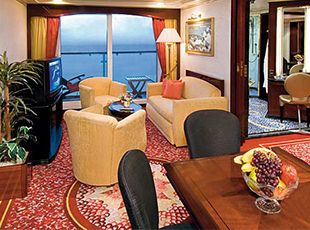
Revel in spacious serenity at sea. Our amazing, imaginative and luxurious suites offer only the finest appointments throughout. Plus each can connect to a Balcony stateroom so you can spread out yet stay together.
The images shown are for illustration purposes only and may not be an exact representation of what you find on the ship.
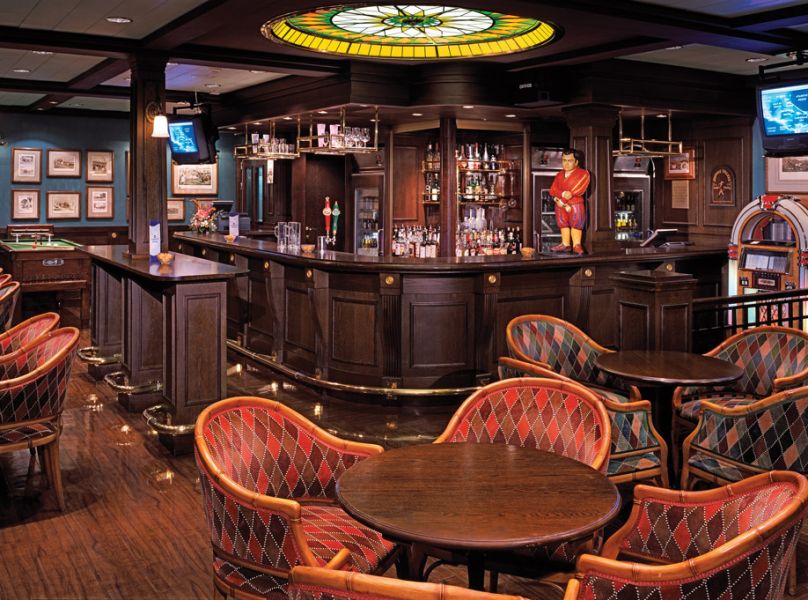
Going down to the pub takes on new meaning at Henry's Pub, a traditional English Pub featuring Dart Boards, large screen TV's, Fish n' Chips and the proper beer on tap.
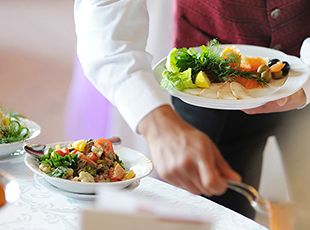
Available 24 hours a day, simply pick up the phone and order breakfast, lunch, dinner or late-night munchies. A room service fee may apply.
Price Per Person: Room Service Fee may apply.
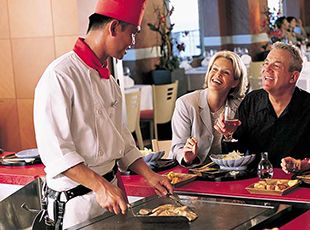
Sit at a lively shared table as a skilful chef perfectly prepares shrimp, steak, chicken and fried rice on a large steel grill. And you've got a front row seat to all the sizzles and surprises in our Japanese restaurant.
Price Per Person: Cover Charge Applies.
The images shown are for illustration purposes only and may not be an exact representation of what you find on the ship.
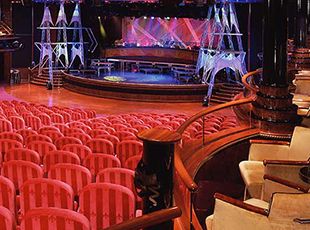
It's showtime! And we've got a really big show for you at the Stardust. Enjoy Broadway and Vegas-style shows with cocktails before or after dinner in a traditional European opera style auditorium reaching up two decks.
The images shown are for illustration purposes only and may not be an exact representation of what you find on the ship.
The images shown are for illustration purposes only and may not be an exact representation of what you find on the ship.
| Return flights including luggage allowance | |||
| Overseas Transfers | |||
| 12 nights aboard the Norwegian Spirit | |||
| Upgrade to More At Sea™ for £349pp and receive the benefits shown below. Book a Haven suite or suite (not Club balcony suites) and receive More At Sea™at no additional cost. | |||
| Premium Beverages
Includes alcoholic and non-alcoholic branded drinks served in all bars, lounges and restaurants throughout your cruise. | |||
| Speciality Dining
Enjoy dining opportunities in selected speciality restaurants depending on number of nights and cabin type. | |||
| Shore Excursion Credits
Receive $50 shore excursion credit per stateroom per excursion. | |||
| Wi-Fi Powered By Starlink
Receive up to 150 minutes Wi-FI per person (guest 1 and 2 only) | |||
| 3rd & 4th Guest Pay Taxes Only
Guests 3 and 4 in the stateroom pay only the applicable tax for the cruise. Available on select sailings only. | |||
| Award winning onboard entertainment | |||
| Complimentary 24-hour room service | |||
| Port Taxes and Fees | |||
 | ABTA and ATOL Protection* | ||
Fly/cruise package |
Date 14th Apr 2025 |
Nts 12 |
Interior £1,565pp |
Oceanview £1,770pp |
Balcony £2,430pp |
Suite £5,565pp |
Interior £1,565pp |
Oceanview £1,770pp |
Balcony £2,430pp |
Suite £5,565pp |
Date 14th Apr 2025 |
Nts 12 |
Interior £1,565pp |
Oceanview £1,770pp |
Balcony £2,430pp |
Suite £5,565pp |
Interior £1,565pp |
Oceanview £1,770pp |
Balcony £2,430pp |
Suite £5,565pp |
| Interior staterooms from | £1,565pp | ||
| IA | Mid-Ship Inside | £1,875pp | |
| IB | Mid-Ship Inside | £1,860pp | |
| IF | Inside | £1,575pp | |
| IX | Sail Away Inside (Guarantee) | £1,565pp | |
| I4 | Family Inside | £1,855pp | |
| IT | Solo Inside | £1,700pp | |
| Oceanview staterooms from | £1,770pp | ||
| OA | Oceanview Picture Window | £2,105pp | |
| OB | Mid-Ship Oceanview Picture Window | £2,135pp | |
| OF | Oceanview | £1,770pp | |
| OX | Sail Away Oceanview (Guarantee) | £1,905pp | |
| O4 | Family Oceanview | £2,135pp | |
| OT | Solo Oceanview | £1,915pp | |
| Balcony staterooms from | £2,430pp | ||
| BA | Mid-Ship Balcony | £2,995pp | |
| BB | Mid-Ship Balcony | £2,895pp | |
| BC | Balcony | £2,865pp | |
| BX | Sail Away Balcony (Guarantee) | £2,855pp | |
| BF | Balcony | £2,430pp | |
| Suite staterooms from | £5,565pp | ||
| SF | Aft-Facing Penthouse Suite with Large Balcony | £5,565pp | |
| Interior staterooms from | £1,565pp | ||
| IA | Mid-Ship Inside | £1,875pp | |
| IB | Mid-Ship Inside | £1,860pp | |
| IF | Inside | £1,575pp | |
| IX | Sail Away Inside (Guarantee) | £1,565pp | |
| I4 | Family Inside | £1,855pp | |
| IT | Solo Inside | £1,700pp | |
| Oceanview staterooms from | £1,770pp | ||
| OA | Oceanview Picture Window | £2,105pp | |
| OB | Mid-Ship Oceanview Picture Window | £2,135pp | |
| OF | Oceanview | £1,770pp | |
| OX | Sail Away Oceanview (Guarantee) | £1,905pp | |
| O4 | Family Oceanview | £2,135pp | |
| OT | Solo Oceanview | £1,915pp | |
| Balcony staterooms from | £2,430pp | ||
| BA | Mid-Ship Balcony | £2,995pp | |
| BB | Mid-Ship Balcony | £2,895pp | |
| BC | Balcony | £2,865pp | |
| BX | Sail Away Balcony (Guarantee) | £2,855pp | |
| BF | Balcony | £2,430pp | |
| Suite staterooms from | £5,565pp | ||
| SF | Aft-Facing Penthouse Suite with Large Balcony | £5,565pp | |
Fusion Cruises when selling travel arrangements is a trading name of The Midcounties Co-operative Ltd. Fusion Cruises is an Accredited Body Member of Midcounties Co-operative Travel Consortium. (ABTA:P6652, ATOL:6053).
Book with Confidence. We are a Member of ABTA which means you have the benefit of ABTA’s assistance and Code of Conduct.
Some of the flights and flight-inclusive holidays on this website are financially protected by the ATOL scheme but ATOL protection does not apply to all holiday and travel services offered on this website. This website will provide you with information on the protection that applies in the case of each holiday and travel service offered before you make your booking. If you do not receive an ATOL Certificate then the booking will not be ATOL protected. If you do receive an ATOL Certificate but all parts of your trip are not listed on it, those parts will not be ATOL protected. Please see our booking conditions for information, or for more information about financial protection and the ATOL Certificate go to: www.caa.co.uk
